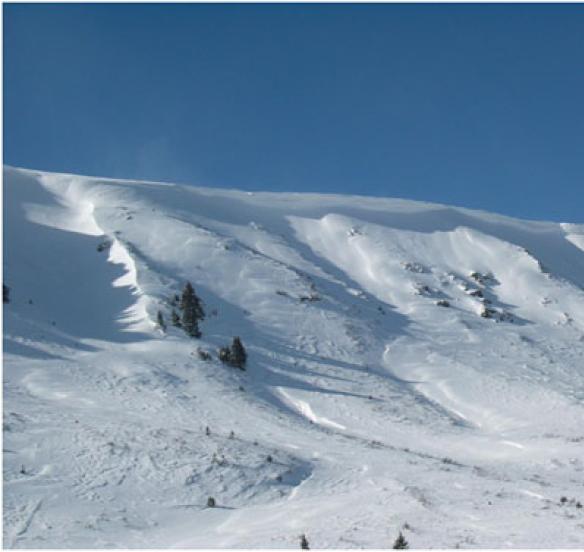Cornice Fall
Cornice Fall is the release of an overhanging mass of snow that forms as the wind moves snow over a sharp terrain feature, such as a ridge, and deposits snow on the downwind (leeward) side. Cornices range in size from small wind lips of soft snow to large overhangs of hard snow that are 30 feet (10 meters) or taller. They can break off the terrain suddenly and pull back onto the ridge top and catch people by surprise even on the flat ground above the slope. Even small cornices can have enough mass to be destructive and deadly. Cornice Fall can entrain loose surface snow or trigger slab avalanches.
Cornices can never be trusted and avoiding them is necessary for safe backcountry travel. Stay well back from ridge line areas with cornices. They often overhang the ridge edge and can be triggered remotely. Avoid areas underneath cornices. Even a small Cornice Fall can trigger a larger avalanche and a large Cornice Fall can easily crush a human. Periods of significant temperature warm-up are times to be particularly aware of.
Read about Cornice Fall in “Decision Making in Avalanche Terrain: a fieldbook for winter backcountry users”.
How They Form
Cornices develop whenever snow is available for transport and the wind is sufficiently strong to move the snow. The ideal wind speed for cornice development is 15 to 25 mph. Stronger wind speeds tend to move snow further down the slope, which creates other hazards (see Wind Slab, Persistent Slab). Cornices can form quickly with favorable wind speeds and abundantly available snow, typically following a recent storm. Multiple wind events over time generate large overhanging cornices comprised of numerous hard snow layers often interspersed with soft weak snow layers or hollow tunnels.
Where They Form
Cornices form on the downwind (leeward) side of sharp terrain features. Ridges above the treeline are the most common locations. Cornices also form downwind of vertical ridge lines and tops of couloirs, in a process referred to as cross-loading. The largest Cornices form over time in areas that receive persistent wind from a similar wind direction. A common example is an above treeline saddle that funnels persistent winds, resulting in a Cornice that increases in size through the winter season. In Colorado, high-elevation winds typically blow from the southwest through the northwest; hence, large Cornices are more likely to form on the easterly side of terrain features.
Timing and Triggering
Cornices develop in periods ranging anywhere from hours to all season. A brief wind event following storm snow quickly generates soft cornices on the lee of any terrain feature. Soft wind cornices are easy to trigger artificially. If they are not large, then they are often manageable by themselves. Soft Cornice Fall, however, can run long and fast while quickly entraining additional snow that results in a much larger and more dangerous avalanche. A longer wind event, typically lasting at least a day, generates larger and harder Cornices. These stiff Cornices may appear supportive of a human, but they cannot be trusted. Additional weight, from more snow load or a human, can result in a crack that easily propagates resulting in a Cornice Fall. This can happen from a distance resulting in a remote release. Cornices can build to very large sizes through the winter. These large Cornice Falls are difficult to trigger, but if they do, the consequences can be deadly.
Recognition
Fortunately, Cornices are easy to see. Weather and terrain awareness are the best tools for recognizing potential cornice problems. When planning a backcountry trip, use topographic maps to learn where potentially hazardous cornices can form. Pay attention to weather observations during the past several days and wind forecasts to understand where Cornices are forming. While in the backcountry, look for cornice formation on the lee of terrain features. Look for local terrain-driven wind effects, which may generate Cornices in unexpected locations. Pay attention to unusual weather events. For example, winds from the east (often associated with a Front Range upslope storm) generate Cornices on westerly aspects.
Treatment and Avoidance
Cornices can never be trusted; and hence, avoiding them is necessary for safe backcountry travel. While moving along ridge lines stay well back from areas with cornice formation. Cornices often overhang the ridge edge and added weight can release the cornice, often from a remote distance. If necessary, use a probe pole to determine the existence of hard ground underneath the snow. Avoid areas underneath the Cornices. Even a small Cornice Fall can trigger a larger avalanche that runs far downhill. Large Cornice Falls can easily crush and kill a human. The spring season, or any period of significant temperature warm-up, are times to be particularly aware. Large Cornice Falls are most common during these weather regimes.


